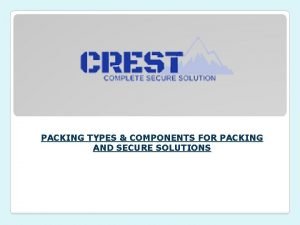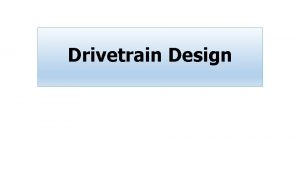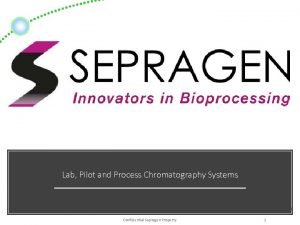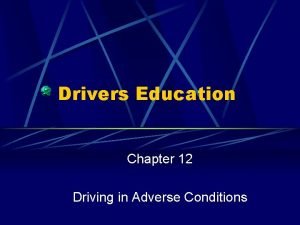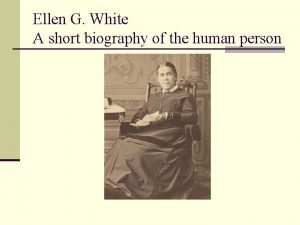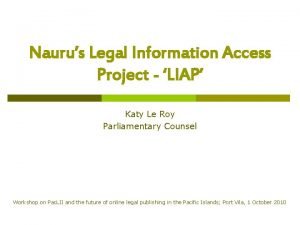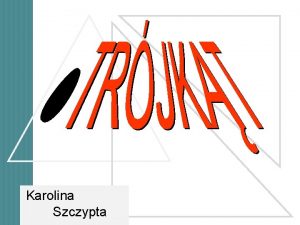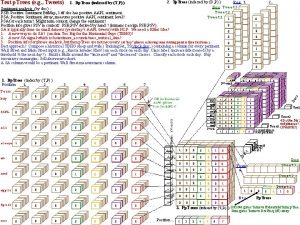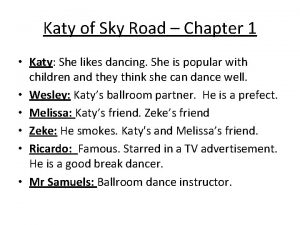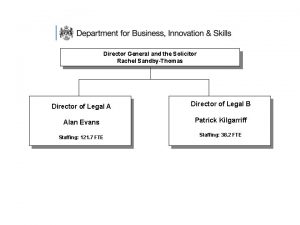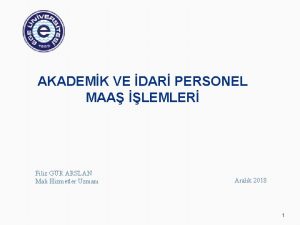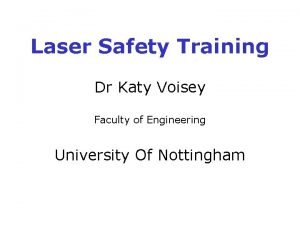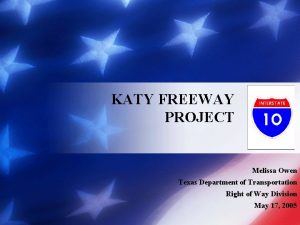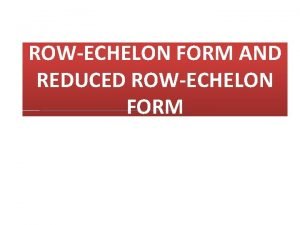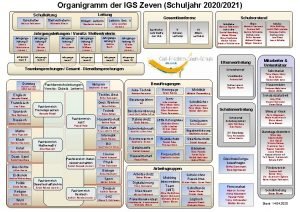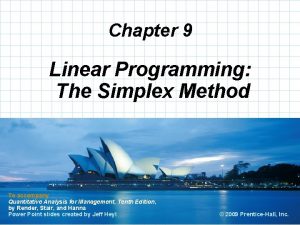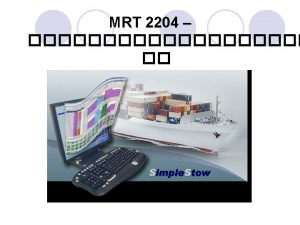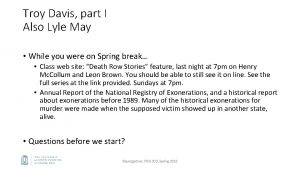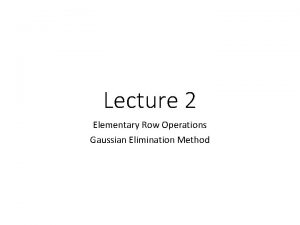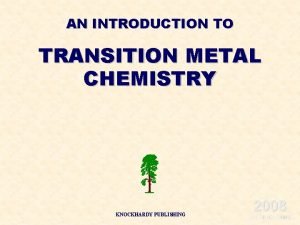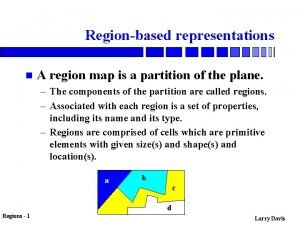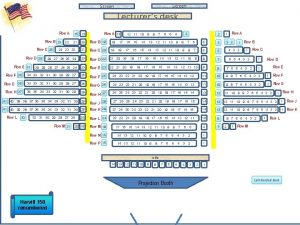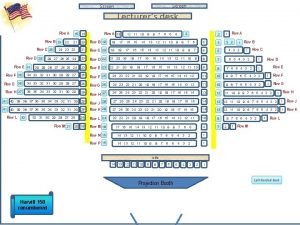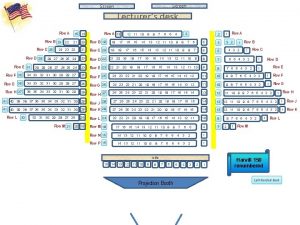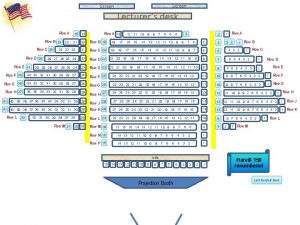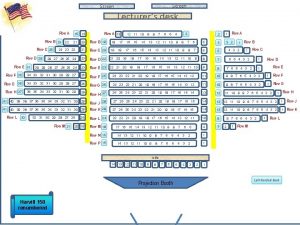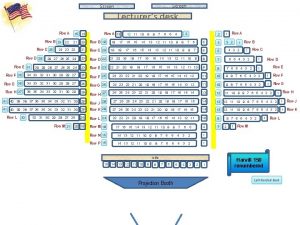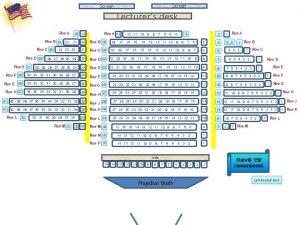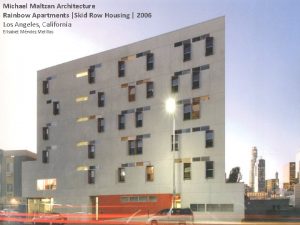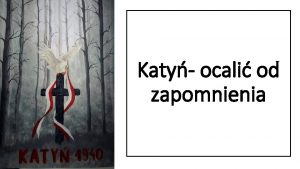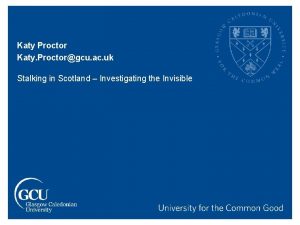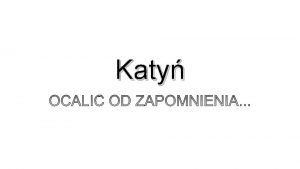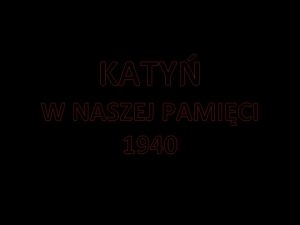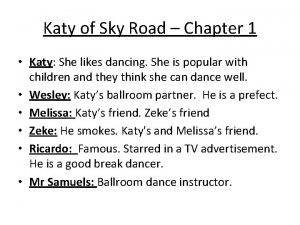MAT in Skid Row Katy White MD Jason





















































- Slides: 53

MAT in Skid Row Katy White, MD Jason Nacorda, DO October 25, 2018

Objectives • Understand steps needed to implement an MAT program in a community health setting in Skid Row • Discuss the complex journey of a person with opioid dependence • Understand 3 health disparities within this predominantly homeless community

Los Angeles Christian Health Centers • We are an FQHC that provides low-cost and no-cost health services throughout Skid Row, Boyle Heights and South Los Angeles. • Founded in 1995, operating in a small, 100 year old SRO hotel owned by the Los Angeles Mission. Federally Qualified Health Center in 2004, receiving government funding to serve the homeless population. We later received funding to serve the public housing populations as well, in Boyle Heights and South Los Angeles. • In 2017, our staff of approx. 150 cared for more than 10, 500 people through over 62, 000 medical, dental, social work, optometry, substance use and mental health visits. We had 582 substance abuse visits in 2017, vs 106 in 2016 • Our network –which is focused on improving access for those who are homeless and living in public housing– includes 2 full-time clinics , 13 parttime satellite sites, and 3 functioning street teams. Mission: To show God’s love by providing quality, comprehensive health care services to the homeless and underserved.

Joshua House in Skid Row

Need for MAT Services at LACHC • High amount of substance use in Skid Row, our target neighborhood – About 30% of the patients we serve struggle with substance use – Significant number of our patients use opioids, both heroin and opiate medications

LACHC’s MAT Story • Received a HRSA Behavioral Health Integration grant in late 2014 - Increased number of Mental Health staff – Increased our capacity to conduct SBIRTS (Screening, Brief Intervention, Referral for Treatment)– highlighted need for greater subst use services • Received a HRSA Substance Abuse Services Expansion grant 2016($325 K), and LA Care Cross-Sector grant 2016 ($150 K) – Allowed for partnership with Homeless Health Care LA (HHCLA) – Funded 2 part time HHCLA physicians to do MAT (8 hours/ week) – Also funded an outreach worker, substance abuse counselor, some medications/supplies/client incentives. – Funded outreach worker for SBIRTS in clinic, thru mid-2018

LACHC’s MAT Story (Continued) • Early 2016: 2 physicians at LACHC applied for DEA Xwaiver • Summer 2016: Worked with part-time HHCLA physicians/staff to transition to using our EMR to expand detox services/induction to Buprenorphine for heroin addicts; detox/inductions at HHCLA center for harm reduction– initial plan was inductions at HHCLA, maintenance at LACHC • Fall 2016: Hired another physician to champion MAT program at LACHC, sent him to a CSAM training

LACHC’s MAT Story (Continued) • Fall-winter 2016 -2017: Got more physicians and midlevel provider waivered • Since Fall 2016: program support through TAPC grant (3 in-person learning sessions, monthly coaching, monthly Project ECHO meetings) and CSAM webinars • Since Fall 2016: slow ramp up of maintenance and home induction patients

Skinner Box Rats - 1960’s • Rats would receive injection of heroin when pressing on lever • Some rats dosed themselves to the point of not eating/drinking and starved • Heroin thought to be a “demon drug” • Any exposure would lead to life-long addiction

Rat Park - 1970’s • Bruce Alexander • Professor of Psychology in Vancouver • Knew that rats were highly social, sexual and industrious creatures • Thought that keeping rats in Skinner boxes was unnaturally isolating • Would removing the rats from isolation yield different results?

Rat Park • Unlimited access to opioids • 200 x size of Skinner box • 95 sq ft • Many rats from both sexes • Platforms for climbing • Tin cans for hiding • Wood chips for strewing around • Running wheels for exercise • Compared opioid use between “Rat park” rats and isolated rats

Skinner Boxes, Lab Rat Housing

Rat Park

Rat Park Results • Heroin use was up to 19 x higher in isolated rats • Rat Park rats preferred social life and community engagement

ACE Study - 1998 • Examined association b/w childhood abuse and adult health risk behaviors • Psychologic, Physical, Sexual, Household dysfunction • ACE assoc. with earlier initiation and increased likelihood of substance use • > 4 ACE lead to 5 -fold increased risk of substance use and 10 -fold increased risk of injection use

Risk Environments • Promotes the understanding of harm as contingent on relationships to environment • Types of environments • Physical, Social, Economic, Policy • Redistributes responsibility for harm as something shared between individuals and socio-economic structures • Encourages consideration of both personal agency and responsibility of society

Complex Pathophysiology • Biologic, Psychologic, Social, Environmental, Economic, Political • Cumulative impact of multiple risk factors across time • Variation in symptoms and prognosis • Only about 10% of people who use substances will develop substance use disorder

LACHC MAT Care Team • Began prescribing in Fall 2016 • Currently, 6 waivered LACHC providers, 3 of whom are actively prescribing • LACHC Pharmacy provides Buprenorphine for uninsured patients

Collaborative Partnership: Homeless Health Care Los Angeles • Center for Harm Reduction • Needle Exchange • Group Counseling/Accupuncture/Computer Access • Two X-Waivered Physicians • Case managers • SUD Counselors

Harm Reduction Model • Compassionate pragmatism • Emphasizes individuals choice and goals they identify as meaningful • Tolerance of treatment goals other than abstinence • Expands services available to people who have not benefited from traditional, abstinence-based treatment

Opioid use/dependence • We do not use pejorative terms • Abusers/Addicts • Dirty/Clean • Using only objective terms • Opioid use/dependence • Positive/Negative (i. e. UDS findings)

Homeless Healthcare LA • Offer MAT Inductions to clients that already utilize the Needle Exchange, etc. • Severe Opioid Dependence • Use Buprenorphine alone • Direct observation dosing, in-clinic induction • Meet with SUD counselors • 2 -day follow up • 14 -21 day “Detox” Program

Detox to Maintenance • Pts who complete “Detox” Program at HHCLA • Transition care to Maintenance at LACHC • “Warm-handoff” from HHCLA • Case managers • EMR progress notes

Patient Stories - Mr. and Ms. S • Mr. and Ms. S, both with opiate pill and heroin use • Uninsured • Both were struggling to hold jobs • Financial issues/Housing issues • Strained relationship • Medical issues

Patient Stories - Mr. S • Initially, did not want to be on Buprenorphine long-term • Wanted to be on Buprenorphine for “detox” • Induced at HHCLA in 9/2016 • Transitioned to LACHC maintenance • UDS was + MOP, + BZO until 5/2017 • Last + MOP was 8/2017 • After 11 months on Buprenorphine

Patient Stories - Mr. S (cont) • Current goal - To stay on Buprenorphine longterm • Doing very well at work, recent promotion • Healthy relationship • Spending more time with family and friends • Has referred friends to LACHC MAT program • Returns to clinic monthly

Patient Stories - Ms. S • Opiate pills to Heroin use • Initial goals of Buprenorphine “Detox” • Wanted to be off all opioids • Induced at HHCLA in 9/2016 • Transitioned to LACHC maintenance • UDS was + MOP until 5/2017 • After 4 -week Rx of Buprenorphine • Voiced she prefers 2 -week Rx’s

Patient Stories - Ms. S (cont. ) • Began attending Cosmetology school in 5/2017 • Graduated and began work in Make-up Department • Happy in her relationship, engaged • Currently with stable job • Stable financially • Returns to clinic monthly

Patient Stories- Health Disparities • • Homelessness/Housing issues Low-income Uninsured Poor social support Transportation difficulty History of incarceration History of physical/sexual abuse

Pathways to LACHC MAT • HHCLA “Detox” Program Completion • HHCLA Clients who prefer Maintenance • Walk-ins • Online Registries • “In-House” Referrals • Existing LACHC Patients • MAT patient family/friends

LACHC MAT • Do not perform In-Clinic Inductions • Utilize NYU School of Medicine- Packet for “Home” Inductions • Induction Guidance • Timing of Dosing • Dosage amount • Follow up



Initial MAT Visit • Urine Drug Screen • Buprenorphine vs other opioids • Psychosocial Assessment • Discuss Patient Goals (Short vs. Long term) • Check CURES • Liver Function Tests • Prescribe Naloxone Kit • Buprenorphine/Naloxone • 2 -7 day follow up

Follow-Up MAT Visit • Urine Drug Screen • Challenges/successes • Patient goals • Cravings/Dosage • Offer in-house services • 2 -7 day follow up

Patient Stories - Ms. K IV Heroin Use for over 20 years Methadone program Also, with benzodiazepine use History of incarceration History of physical/sexual abuse Many difficult social factors • Work, housing, financial, transportation • Induced at LACHC in 6/18 • Needing multiple inductions • Following up weekly • • •

In-House Patient Services • Case management • Housing, Employment, Transportation • Mental Health • Medical/Dental/Optometry • Enrollment & Retention • SUD counselor available once/week

Multiple MAT Sites • Joshua House • Center for Harm Reduction with HHCLA • Midnight Mission, other satellite sites in Skid Row • Pico Aliso Community Clinic in East LA

Patient Stories - Mr. R • Chronic pain • Noted as “difficult patient” • Previous hx of heroin use • Fired by pain specialist • Endorsed feelings of anxiety, restlessness between dosages of opiates • Family arguments, stress • Buying methadone off the street

Patient Stories - Mr. R (cont) • Induced at LACHC in 4/2018 • + MTD, + MOP before induction • - MTD, - MOP after induction • Reports improved anxiety, restlessness • Improved relationships with wife and children • Referred family members to our MAT program

MAT Coaching • Program Support thru TAPC Grant • Monthly Coaching Conference Calls • Brian Hurley, MD, Addiction Psychiatry • Difficult Cases • Inductions • Dosages • Diversion • Benzodiazepines, Methadone, Opiates

MAT Team Unity • MAT providers work within similar guidelines • Use of Treatment Templates to adhere to standard • Monthly meetings with HHCLA to discuss program challenges

Current Status of MAT • 2017 • 100 unique patients • 2018 • January - September • 105 unique patients • Currently, 35 MAT patients monthly

• • Barriers- Prescriber Perceptions “Difficult” patients Time consuming visits High risk of diversion of Buprenorphine Many missed appointments Disturbing to other patients Manipulative Differing goals of treatment

Barriers. Patient challenges • • No/Inactive insurance No ID/phone Difficulty making appointments Can’t leave partner/tent/belongings Don’t trust doctors/medical society Other substance use Psychiatric disease

Patient Stories - Mr. H • • Undocumented, uninsured IV Heroin use for 20 years History of incarceration Previously homeless Married but strained relationship Previously attempted Methadone program Induced at HHCLA in 3/2017 • Needed multiple inductions • Transitioned to LACHC Maintenance in 6/2017

Patient Stories - Mr. H (cont) • Artist by trade • Financially support his family • Reports relationship with wife is the best it has ever been in 20 years • Expecting their first born child this year • Enjoys working consistent job • Returns to clinic monthly



Program Growth • To further integrate mental health and case management services • Increase cultural competency, to be more sensitive to diversity and individuality of our community • To continue to partner with patients/community to improve program treatment goals

Healing • “The opposite of addiction is not sobriety. The opposite of addiction is connection” - Johann Hari

Questions? Jason Nacorda; jnacorda@lachc. com- MAT Champion Katy White; kwhite@lachc. com- Chief Medical Officer

Resources • Alexander, Bruce. The Globalization of Addiction: A study in poverty of the spirit. (Oxford Univ. Press, 2010) • P Denning, J Little. Practicing Harm Reduction Psychotherapy, Second Edition: An Alternative Approach to Addictions. The Guilford Press; 2 nd edition (October 24, 2011) • GA Marlatt, Arthur W. Blume & George A. Parks (2001) Integrating Harm Reduction Therapy and Traditional Substance Abuse Treatment, Journal of Psychoactive Drugs, 33: 1, 13 -21 • GA Marlatt, ME Larimer, K Witkiewitz. Harm Reduction, Second Edition. Pragmatic strategies for Managing High-risk behaviors. The Guilford Press; Second edition (December 7, 2011) • Rhodes, Tim. “Risk environments and drug harms: A social science for harm reduction approach. ” The International Journal of Drug Policy. May 2009. Volume 20, Issue 3, Pages 193– 201.
 Binary
Binary Single row and multiple row functions in sql
Single row and multiple row functions in sql Betty bought butter
Betty bought butter British pendulum tester
British pendulum tester Vex mecanum wheels
Vex mecanum wheels Pre crash safety toyota
Pre crash safety toyota Crest lashing and packaging private limited
Crest lashing and packaging private limited Robot drivetrain types
Robot drivetrain types Sepragen chromatography
Sepragen chromatography What is overdriving your headlights mean
What is overdriving your headlights mean In coming to a stop a car leaves skid
In coming to a stop a car leaves skid Protech anti skid floor agent
Protech anti skid floor agent Overdriving headlights means
Overdriving headlights means Free verse poem examples for students
Free verse poem examples for students Biography of ellen g white
Biography of ellen g white Katy le
Katy le Rezerwat kozie kąty
Rezerwat kozie kąty Katy perry firework figurative language
Katy perry firework figurative language Trojkat egipski 3 4 5 katy
Trojkat egipski 3 4 5 katy Katy gil
Katy gil Twierdzenie o stycznej i siecznej dowód
Twierdzenie o stycznej i siecznej dowód Idioms in the song roar
Idioms in the song roar Wyspa z której pochodził pitagoras
Wyspa z której pochodził pitagoras Przeciwległe kąty
Przeciwległe kąty Ma boki parami równe i wszystkie kąty równe
Ma boki parami równe i wszystkie kąty równe Power bi and vsts
Power bi and vsts What figurative language is dancing through the fire
What figurative language is dancing through the fire Katy huberty twitter
Katy huberty twitter Katie johnson nar
Katie johnson nar Tikkop meaning
Tikkop meaning Kąty zewnętrzne w trójkącie
Kąty zewnętrzne w trójkącie ¿cuáles son las potencialidades de mojo y katy?
¿cuáles son las potencialidades de mojo y katy? Katy shrimplin
Katy shrimplin 3600 ek gösterge tablosu
3600 ek gösterge tablosu Wzór na pole sześciokąta
Wzór na pole sześciokąta La olla de katy
La olla de katy Katy voisey
Katy voisey Katy freeway 26 lanes
Katy freeway 26 lanes Katy james
Katy james Matt thiessen and katy perry
Matt thiessen and katy perry Roar poem
Roar poem Sentencje pitagorasa
Sentencje pitagorasa Row space of a matrix
Row space of a matrix Echelon definition
Echelon definition Jmp import excel
Jmp import excel Given the base address of an array b 1300
Given the base address of an array b 1300 Eren badur
Eren badur In simplex table the pivot row is computed by
In simplex table the pivot row is computed by Bay plan
Bay plan Akiel denkins
Akiel denkins Elementary row operation
Elementary row operation Knockhardy chemistry
Knockhardy chemistry Super projection vertica
Super projection vertica Row major
Row major






